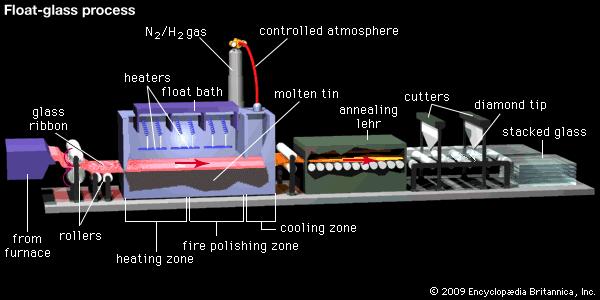What is Glass?
The glass is a solid material which is transparent and brittle. It is manufactured by the application of massive amounts of heat to sand or quartz. Glass is an amorphous inorganic, homogeneous transparent or translucent material which can be moulded into any shape. In other words, glass is defined as an inorganic product of fusion which has cooled to a rigid condition without crystallising.

Transparent Architectural Glass
Before the human started the race for the glass manufacturing, they had found natural glass in the volcanic eruption and also in fulgurites.
How Glass Is Made?
Making of glass sheet was a slow and expensive process, and required hard work at the early stage. But glass manufacturers invented the new technique of glass manufacturing and marketing strategies to sell the glass products. The new process of glass manufacturing is easy, cheap and productive and eventually, it becomes very famous in industries.
The manufacturing process of glass is carried out by following simple steps.
- Prepare the batch of raw materials.
- Melt the raw materials in the furnace.
- Manufacturing of glass into desired forms.
- Annealing process.

Process of Glass Manufacturing
Courtesy - Britannica
The glass is made by melting mixture of following ingredients.
- Pure sand (Si O₂)
- Soda (Na OH) or Potash (K OH)
- Lime or chalk (Ca CO₃) at a temperature of over 1000° C.
In other words, it is a mixture of silicates of sodium, potassium, calcium.
Following are the three-part operations of the modern glass company.
- Batch house (Handling of the raw materials).
- Hot end (Includes the manufacturing process, the furnaces, annealing ovens, and forming machines).
- Cold end (Includes the product-inspection and -packaging equipment).
After all the treatment, manufactured glass can be stored as per the required shape & size and then sent it to the retail outlet store.
What is the Role of Architectural Glass in construction?
The manufacturing of different types of glasses needs different raw materials in particular proportion and different treatments. There are many types of glass depending upon their base materials. It means the proportion of silica in their chief constituents. Furthermore, glass is also classified depending upon their modified properties or function for the architectural features.
Nowadays the homeowners have many varieties of architectural glass according to their safety, security and budget. Different characteristics and properties of glass make it important building materials for the construction of the house.
Architectural glass is a wonderful innovation as it has multiple uses and benefits according to its varieties in colors, strength, durability and transparency. Nowadays architectural glass becomes one of the most decorative building materials for the construction of the house.
Architectural glass has become multipurpose material to meet the particular requirements of the homeowners. The properties of glass can be altered simply by changing its chemical composition by adding few more ingredients.
Architectural glass is reinforced, toughened and laminated for strength, durability, visibility and safety features. Hence the advantages of glass make it a perfect and decorable material for the construction industries. In the current scenario, building material like architectural glass becomes the first choice of architects, interior designers and civil engineers for the construction of houses. Architects sometimes use glass in façade of the building. Various glass products are available in the market to use on the exterior.





